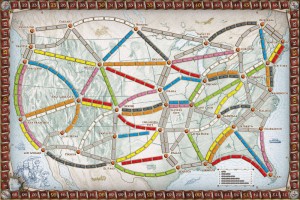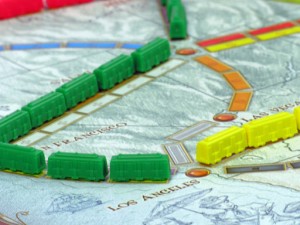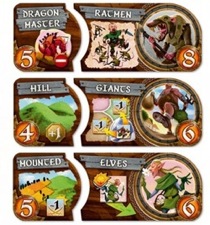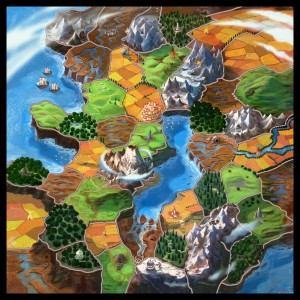Friday Night Unplugged #7: Ticket to Ride/Smallworld
- Updated: 21st Dec, 2012
Welcome to the last of this year’s run of Friday Night Unplugged. It’s a double special this week as we look further into one of our recommended games for Christmas: Ticket to Ride. We’ll also be checking out Smallworld. Often cited as a lighter, less luck based Risk, could these be the games to sway new people into the world of designer tabletop gaming? Let’s find out.
This week won’t be featuring play guides, mainly because it just doesn’t suit the games in question and partly because it’s nearly Christmas. You should be playing games, not reading about them.
Ticket to Ride
We first mentioned Ticket to Ride a few weeks ago in our Christmas guide. Thanks to the game’s length we won’t be guiding you through a full playthrough today because well… Ticket to Ride sounds inherently boring when you explain it. Instead we’re going to explain how it works.
The Basics
Ticket to Ride is a train-placing game. Yes, trains. Faced with a map of early USA laced with coloured routes and connections between cities, the players aim to complete as many destination cards as they can. Drawn at the beginning of the game and kept secret by each player, destination cards each list 2 locations. It’s then up to the players to connect those destinations over the course of the game.
Turns are even easier to learn. You can either play your coloured train cards to claim a route of the same colour and number of spaces as the cards you play. Or you can draw 2 cards from the selection area which is split into a face-down draw pile and 5 face-up cards that are replaced from the draw pile as they are taken. Once a route has been claimed you place your train pieces on it and nobody else can use that route.
What We Thought
If you can’t tell already we love Ticket to Ride for its simplicity. We also love it for its complexity. The vast sprawling map seemingly is more than big enough for everyone. Especially in a 3 player game. Throw in a few more players and you have a game that changes from a relaxing card game with trains, to a cramped race for key lines. A single 2 train line is enough to cause a large detour which of course makes life more difficult for the person who was detoured. More often then not when we’re stuck for something to play Ticket to Ride will be pulled from the shelf
Why should I play Ticket to Ride?
Ticket to Ride is a gateway game. It’s easy to teach, new players will have fun learning it’s mechanics and it doesn’t immediately put anyone off with it’s theme. Unless you really hate trains. We love this game and so should you.
Smallworld
Like Ticket to Ride, Smallworld is from Eurogame experts Days of Wonder. Unlike Ticket to Ride, it ditches simplicity and chance to present a smooth and refreshing take on the classic Risk style.
The Basics
At the start of the game players choose a race and power from a group of randomly drawn tiles. The Fantasy laced themes of Smallworld mean that everything from vampires to halflings and fish men are present in the menagerie. Powers add small bonuses for things like claiming grassland, owning a forest or defeating an opponent. Turns are simple to read but complex to really master.
- Conquest: Players claim regions using their race tokens by outnumbering items/other tokens in that region. A redeployment phase allows you to move around some of the already placed pieces at the end of the conquest
- Scoring: Points are scored for each region claimed during the conquest phase, bonus points are awarded for race powers.
Smallworld does have a few mechanics that really set it apart from other territory control games. For one, races can be entered into decline. They will keep scoring for you so long as their pieces remain on the board and you can pick a new race+power combo from the stack. While there are plenty of forces for you to dominate with, there isn’t much room to do so. Smallworld comes with 2 boards, one for a 3 player game and one for a 4+ game. Each has limited space forcing players into making moves against their opponents.
What We Thought
Smallworld is probably one of the most divisive games we’ve seen here on FNU. I personally love it – the conquest elements and the fact you have no choice but to spread into your opponents’ regions after a few turns force your hand. You will have to be ruthless to score point.
If you’re looking for something that doesn’t intimidate or leave new players in the dust while they learn the ropes, Smallworld can still be just that. It’s simple enough to learn that after a few turns, anyone you introduce to it will be able to play at the same level.
One of the things we did love was the Race + Power mechanic. Being able to draw new races or insane combinations such as Flying Ratmen or Marauding Halflings was definitely part of its fun factor.
Why should I play Smallworld?
If you don’t like Risk and find the idea of the “conquer and redeploy” a little boring then Smallworld probably isn’t for you. When the group tested it we found that while Smallworld was still interesting to play if you don’t like those things, it wasn’t play again levels of fun. However if you like Risk, competitive PvP gameplay and want to try something that doesn’t last as long per game then Smallworld is definitely for you.
That’s All, Folks
That’s it for the first “season” of FNU. We ventured through space in Star Trek: Catan, killed zombies in Zombicide, lost our way with Tsuro, stole from the rich in Cadwallon: City of Thieves and raided dungeons in Super Dungeon Explore. We hope you enjoyed following us on our travels through tabletop land.
We’ll be back in the new year with a new run of FNU and hopefully a few surprises. Have a good Christmas all and remember keep gaming!
Hey boardgamers, help us out with the new season. What did you enjoy about Friday Night Unplugged? What did you dislike? We want to make it better for you in 2013.







Follow Us!